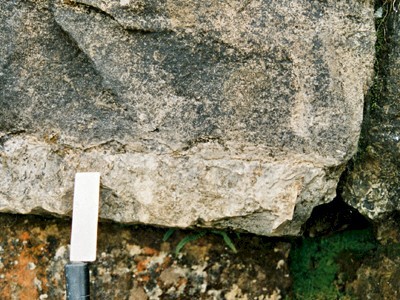Earth Science Conservation Review
| Binnawooda Spring | Tyrone |
| Site Type: | Stream section |
| Site Status: | ESCR |
| Council area: | Strabane District Council |
| Grid Reference: | H2476 |
| Google maps: | 54.63206,-7.62835 |
| Rocks | |
|---|---|
| Rock Age: | Carboniferous (Arundian, Chadian, Visean) |
| Rock Name: | Bin Mountain Sandstone Formation, Claragh Sandstone Formation, Tyrone Group |
| Rock Type: | Limestone, Mudstone, Sand, Sandstone, Siltstone |
| Interest | |
| Fossil Groups: | Brachiopod, Coral, Foraminifera, Gastropod, Nautiloid, Trace fossil, Trace fossils |
Summary of site:
Around the 250m contour on the north face of Bin Mountain in the Binnawooda area, a spring emerges on the east bank of the farm lane. The section of rocks in the bank and the immediate area around exposes the contact between the Claragh Sandstone Formation below and the Bin Mountain Sandstone Formation above. Both these formations belong to the Visean epoch of the early Carboniferous period.
The Claragh Sandstone exposed in the stream consists of very thick beds of a sandstone rich in feldspar (an arkose), topped by 3m of fine to medium grained sandstones with gradations of colour from fawn through grey to green. There are also some siltstones. The upper sandstone shows signs of erosion before burial by a grey-green, sandy mudstone (a little over 1m thick) and it incorporates thin limestones formed near the tidal zone. The microscopic fauna and flora of these beds confirms their Visean age.
Just north of the spring line the lowest beds of the Bin Mountain Sandstone are exposed and the section continues in the cliff behind where over 4m of medium to fine grained sandy limestone with an impoverished fauna can be seen. A further 4m of blue-grey, fine to medium grained limestones outcrop in the farm lane extending west of the bend terminating in a thin, grey-green mudstone containing small, calcite filled cavities. All these limestones have been churned up by sediment feeding animals.
Recognisable fossils are rare in these rocks but they are significant where they do occur, particularly the corals Michelinia megastoma and Dorlodotia pseudovermiculare which indicate a Chadian age (confirmed by a range of microscopic foraminifera that suggest the early part of the stage). These rocks are therefore about 350 million years old.
The arkoses of the Claragh Sandstone imply that coarse sediment was swept into a coastal marine environment and rapidly buried. The Bin Mountain Sandstone Formation in its early stages appears to have been deposited in a shallow marine environment capable of sustaining only a limited fauna of visible fossils, chiefly brachiopods and corals.
At the time of formation, these rocks were marginal to a continent moving northwards over the equator at the rate of a couple of centimetres a year.
The site is an open fell side of upland grazing with no obvious threats.
The Claragh Sandstone exposed in the stream consists of very thick beds of a sandstone rich in feldspar (an arkose), topped by 3m of fine to medium grained sandstones with gradations of colour from fawn through grey to green. There are also some siltstones. The upper sandstone shows signs of erosion before burial by a grey-green, sandy mudstone (a little over 1m thick) and it incorporates thin limestones formed near the tidal zone. The microscopic fauna and flora of these beds confirms their Visean age.
Just north of the spring line the lowest beds of the Bin Mountain Sandstone are exposed and the section continues in the cliff behind where over 4m of medium to fine grained sandy limestone with an impoverished fauna can be seen. A further 4m of blue-grey, fine to medium grained limestones outcrop in the farm lane extending west of the bend terminating in a thin, grey-green mudstone containing small, calcite filled cavities. All these limestones have been churned up by sediment feeding animals.
Recognisable fossils are rare in these rocks but they are significant where they do occur, particularly the corals Michelinia megastoma and Dorlodotia pseudovermiculare which indicate a Chadian age (confirmed by a range of microscopic foraminifera that suggest the early part of the stage). These rocks are therefore about 350 million years old.
The arkoses of the Claragh Sandstone imply that coarse sediment was swept into a coastal marine environment and rapidly buried. The Bin Mountain Sandstone Formation in its early stages appears to have been deposited in a shallow marine environment capable of sustaining only a limited fauna of visible fossils, chiefly brachiopods and corals.
At the time of formation, these rocks were marginal to a continent moving northwards over the equator at the rate of a couple of centimetres a year.
The site is an open fell side of upland grazing with no obvious threats.
| Enlander, I., Dempster, M. & Doughty, P., 2025. Binnawooda Spring, County Tyrone, site summary. [In] Earth Science Conservation Review. https://www.habitas.org.uk/escr/summary.php?item=220. Accessed on 2025-04-03 |
| Previous Site | Next Site |

